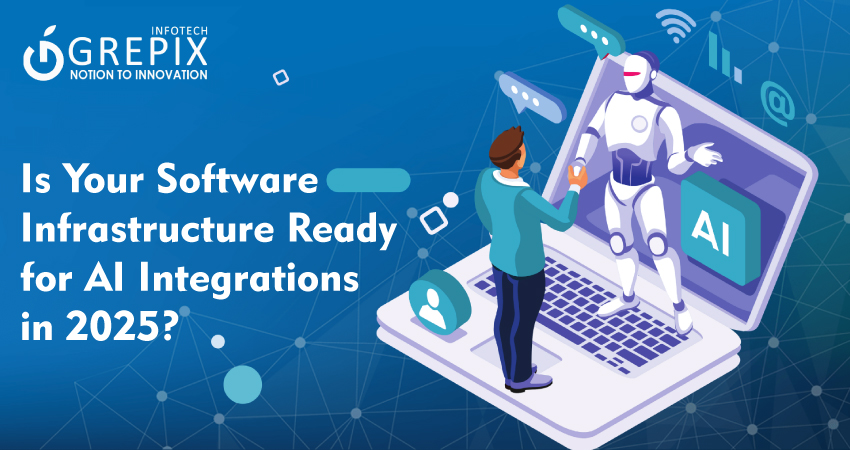Is Your Software Infrastructure Ready for AI Integrations in 2025?
Artificial Intelligence (AI) is no longer a futuristic concept it’s here, and it’s rapidly transforming how businesses operate. From automating mundane tasks to providing valuable insights, AI can significantly enhance your organization’s efficiency. But, as the AI wave continues to gain momentum, the question arises: Is your software infrastructure ready for AI integrations in 2025?
In this blog post, we’ll explore the critical aspects of preparing your software infrastructure for AI, discuss the key challenges involved, and provide actionable tips for ensuring your systems are AI-ready by 2025. Let’s dive in!
In 2025, AI integration will be pivotal for businesses looking to stay competitive. Building an AI-ready infrastructure involves assessing your current system, upgrading your data capabilities, ensuring real-time data processing, and having the right team in place. By preparing now, you can harness AI’s full potential and drive your business forward.
What Is AI Integration?
Before we delve into the infrastructure, let's break down what AI integration means. Simply put, it’s the process of embedding AI capabilities into existing software systems. Whether you’re looking to use AI for data analysis, improve customer service with chatbots, or optimize business processes, integrating AI involves connecting machine learning models, data processing systems, and algorithms with your current software environment.
Why Is AI Integration So Important in 2025?
As AI continues to evolve, its role in businesses is becoming more pronounced. AI’s ability to make data-driven decisions and automate complex tasks is changing industries worldwide. In fact, companies that embrace AI are often the ones leading the charge in their respective markets.
- Boosting Efficiency: AI systems can handle repetitive tasks quickly and accurately, freeing up human workers for more creative or strategic roles.
- Improved Decision-Making: AI leverages vast amounts of data to provide real-time insights that can help businesses make better decisions.
- Personalization: AI is central to offering personalized experiences, from recommendations on e-commerce platforms to personalized health advice.
However, integrating AI into your existing infrastructure isn’t as simple as installing a new app. It requires a robust system that can support machine learning, large datasets, and real-time data processing.
Preparing Your Software Infrastructure for AI
1. Assess Your Current Infrastructure
The first step in preparing your software for AI is to assess your current infrastructure. Do you have a robust data storage and processing system? Is your network capable of handling the demands of AI algorithms? By answering these questions, you can identify gaps that need to be addressed.
Key considerations:
- Data storage: AI models require large datasets, and storing them efficiently is essential. Ensure your databases are scalable and can handle the data AI systems will generate.
- Data quality: AI’s accuracy depends heavily on the quality of the data. You must ensure that your data is clean, organized, and structured for machine learning.
- Compute power: AI models require significant computing resources. Check whether your servers or cloud infrastructure are capable of handling these demands.
2. Upgrade Your Data Infrastructure
AI is all about data. To get the most out of your AI integrations, you need a solid foundation to store, manage, and process that data. This means having the right tools and platforms in place to make sure your data flows smoothly.
Key elements of a data infrastructure:
- Cloud storage solutions: The ability to scale data storage is crucial. Cloud platforms like AWS, Google Cloud, and Microsoft Azure offer scalable storage solutions that can adapt to growing data needs.
- Data lakes: Data lakes allow you to store raw data, which is crucial for AI applications that need to process vast amounts of data before analyzing it.
- Data pipelines: AI systems rely on clean and consistent data. Automating data collection and cleaning through data pipelines ensures that your AI models are trained on accurate and reliable data.
3. Focus on AI-Ready Systems
AI-ready systems in 2025 need to be designed to handle the unique requirements of AI models. These systems should be able to integrate with machine learning platforms and handle real-time data.
Characteristics of AI-ready systems:
- Scalability: AI applications often grow in complexity. Systems that can scale up to handle larger datasets and more intensive workloads will be crucial.
- Interoperability: Your systems must be able to communicate with third-party AI tools or external APIs. Integrating different AI solutions is a common practice, so ensure your infrastructure is flexible enough to accommodate these integrations.
- Security: AI systems handle sensitive data, so securing your software infrastructure is critical. Implement encryption and access control measures to protect the data being processed by AI models.
4. Invest in Real-Time Data Processing
One of the key factors that make AI so powerful is its ability to process data in real-time. Whether it's analyzing customer behavior or making real-time predictions, AI requires a system that can handle massive streams of data.
Tools for real-time data processing:
- Apache Kafka: A distributed data streaming platform that handles real-time data feeds.
- Apache Spark: A unified analytics engine that allows you to process large-scale data in real time.
- Data streaming services: Cloud-based data streaming platforms can also be used to process data streams efficiently.
5. Machine Learning Model Training and Deployment
AI integrations involve more than just installing software; they also require machine learning models to be trained and deployed. Your infrastructure must be capable of supporting machine learning workflows, from training models to deploying them in production environments.
Key steps for training and deployment:
- Machine learning platforms: Platforms like TensorFlow, PyTorch, and Scikit-Learn provide tools to build, train, and deploy machine learning models.
- Version control for models: Just like software, machine learning models need version control. Tools like DVC (Data Version Control) help track model changes over time.
- Model monitoring: After deployment, it's crucial to monitor the performance of your AI models and make adjustments as necessary.
Also Read: "How AI Chatbots Are Evolving into Virtual Employees in SaaS Platforms"
6. Optimize for AI Scalability and Efficiency
As your AI systems evolve, you’ll need to ensure that your infrastructure can handle increased load. This includes optimizing for better performance, reduced latency, and more efficient resource usage.
Steps to optimize AI scalability:
- Distributed computing: Use distributed computing frameworks to spread out AI workloads across multiple servers or clusters.
- Edge computing: If your AI applications need to process data from IoT devices, consider deploying edge computing solutions that bring computation closer to the data source, reducing latency and bandwidth usage.
7. Prepare Your Team for AI Integration
It’s essential to have the right team in place to successfully integrate AI into your infrastructure. This team should consist of data scientists, machine learning engineers, and software developers who are familiar with AI technologies.
Key skills for your team:
- Data science: Data scientists help prepare, clean, and analyze data to train AI models.
- Machine learning engineering: ML engineers build the algorithms and models that power AI systems.
- DevOps for AI: DevOps engineers ensure smooth integration of AI models into production environments.
Challenges in AI Integration
While AI integration offers immense benefits, there are several challenges to overcome:
- Cost: AI requires significant resources, both in terms of computing power and human expertise. Investing in AI infrastructure can be expensive, especially for smaller businesses.
- Data privacy: With AI processing large amounts of data, ensuring compliance with data privacy regulations (like GDPR) is essential.
- Lack of talent: There’s a global shortage of AI professionals. Finding qualified individuals to build and maintain AI systems can be a challenge.
Conclusion
As businesses look to adopt AI technologies, Grepix Infotech stands as a leading partner in helping companies navigate the complexities of AI integration. With our deep expertise in mobile app development and AI solutions, we ensure your software infrastructure is not only ready for AI but optimized to leverage its full potential.
We understand that every business is unique, and that’s why we offer tailored AI solutions that meet your specific needs. Whether it's enhancing customer experiences through intelligent applications or improving operational efficiency with AI-driven automation, Grepix Infotech has the tools and experience to make it happen.
Our team of skilled professionals ensures seamless integration of AI into your systems, empowering your business to stay ahead of the curve. By choosing Grepix Infotech, you're not just adopting AI; you're embracing the future of technology, with a partner committed to your success.
Let Grepix Infotech help you build an AI-ready system that scales with your business goals. Get in touch today to discuss how we can assist in integrating AI into your mobile apps and software infrastructure, and take your business to the next level in 2025.
Launch your vision with our mobile app development company, where innovation meets excellence to create cutting-edge mobile solutions."
FAQs
1. What is AI integration?
AI integration involves embedding AI technologies into existing software systems to improve efficiency, decision-making, and automation.
2. Why is my software infrastructure important for AI?
Your infrastructure must be scalable, secure, and capable of handling large datasets and real-time data processing to support AI systems effectively.
3. How can I prepare my system for AI?
Assess your current infrastructure, upgrade your data storage, ensure your system is AI-ready, and invest in machine learning model training.
4. What are the challenges of AI integration?
Challenges include high costs, data privacy concerns, and the shortage of skilled professionals.
5. Can Grepix Infotech help with AI integration?
Yes, Grepix Infotech specializes in developing AI-powered solutions and can help you prepare your software infrastructure for AI integration.
Launch your vision with our mobile app development company, where innovation meets excellence to create cutting edge mobile solutions."







